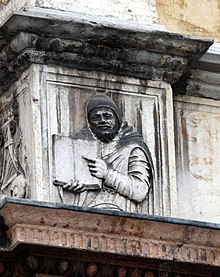City walls of Treviso
The Treviso wall belt is a complex of defenses built over the centuries to defend the city from enemy attacks.
history
Roman wall
Already in prehistoric times there was a Bronze Age settlement in the area of today's historic city center. In 49 BC Tarvisium was made a municipality and subsequently received a first wall wreath. The course of the Roman fortifications of Tarvisium is unclear . The Municipium stood on the island formed by the Botteniga and Sile rivers and thus developed along these waterways.
Abbot Luigi Bailo wrote at the end of the nineteenth century that the excavations carried out near the bridge of San Chiliano, in Via Antonio Canova, revealed the remains of fortifications that he identified as Roman.
For the toponym "Via Cornarotta" (perhaps "Corna rupta" [broken horn]), there is the hypothesis that this should represent the break in the regularity of the decumanus , the vertical lines in the street system laid out at right angles.
Fortification of the fourteenth century
During the 14th century, the fortification of Treviso was equipped with high battlements and connected to the outlying villages by thirteen gates. Over the years, however, many additions to buildings and walls were made that questioned the functionality of this defense system. The suburbs moved closer to the city and had to be included in the expanded city fortifications with walls and towers. Remains of this wall are still visible today in the course of the walls of the 16th century at the Porta Altinia, built next to a former medieval city gate.
After the defeat in the Battle of Agnadello , the cohesion of the Terraferma of the Venetians collapsed under pressure from the French and Germans. Venice decided to fortify the main cities of the mainland, including Treviso. The Council of Ten entrusted the Franciscan Giovanni Giocondo from Verona with the project.
Between 1509 and 1518 the medieval walls were demolished, as were the suburbs and other buildings that existed outside or even inside in the immediate vicinity of the walls, including the choir of the Church of Santa Maria Maggiore, and which stood in the way of urban development.
literature
- Adriano Augusto Michieli: Storia di Treviso. Editrice SIT, III Edizione, aggiornamento a cura di Giovanni Netto. 1981.
- Giovanni Netto: Guida di Treviso. Edizioni LINT, Trieste, 1988, pp. 281-288.
Web links
- Extract from Klaus Zimmermanns : Veneto: The cities and villas of Terraferma (Google books)
Picture gallery
city wall
City gates
Lock system
Individual evidence
- ^ Luigi Bailo: Guida della città di Treviso. Treviso 1872.
- ↑ Giovanni Roman: Il Ducato Longobardo di Treviso in Rivista quadrimestrale di studi vittoriesi IL FLAMINIO Edita dalla Comunità Montana delle Prealpi Trevigiane, n ° 12, 1999 Il Flaminio ( Memento of the original from August 26, 2006 in the Internet Archive ) Info: The archive link was inserted automatically and not yet tested. Please check the original and archive link according to the instructions and then remove this notice. .
- ↑ City wall of Treviso ( Memento of the original from March 4, 2016 in the Internet Archive ) Info: The archive link was inserted automatically and has not yet been checked. Please check the original and archive link according to the instructions and then remove this notice.
- ^ Giovanni Netto: Guida di Treviso. La città, la storia, la cultura e l'arte . LINT Editoriale Associati, 2000, ISBN 88-8190-141-2 .









